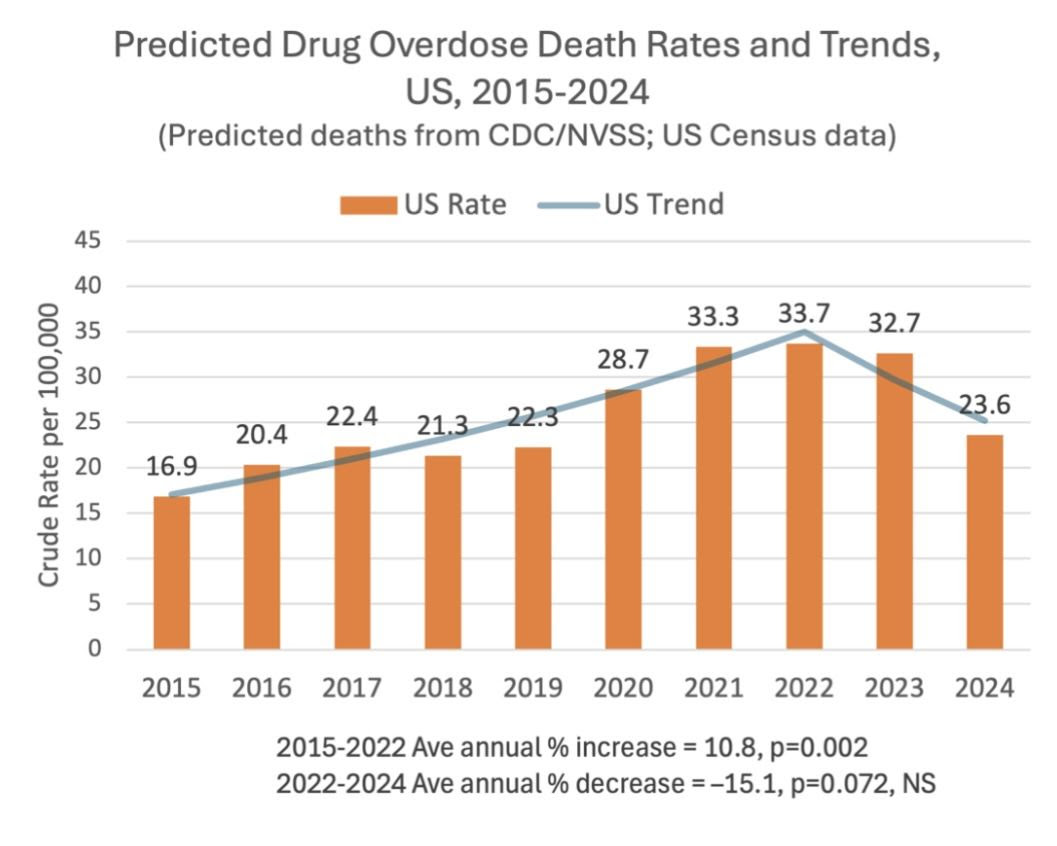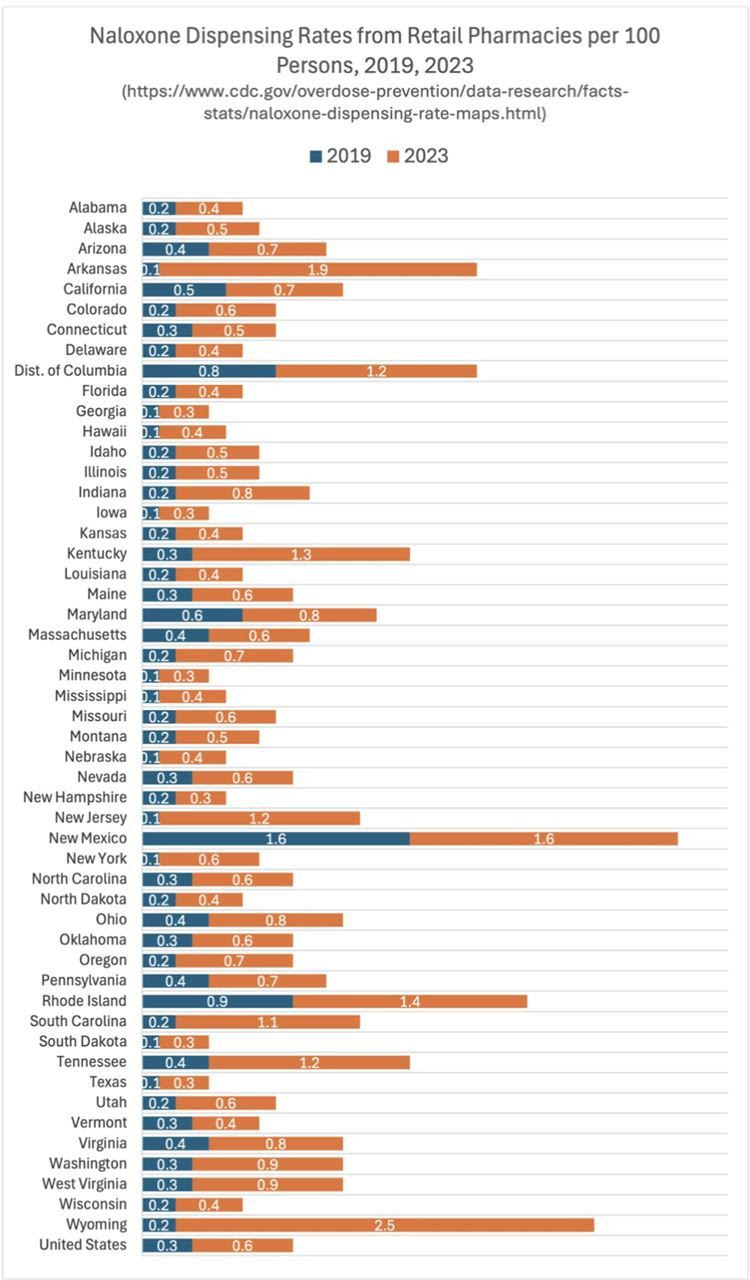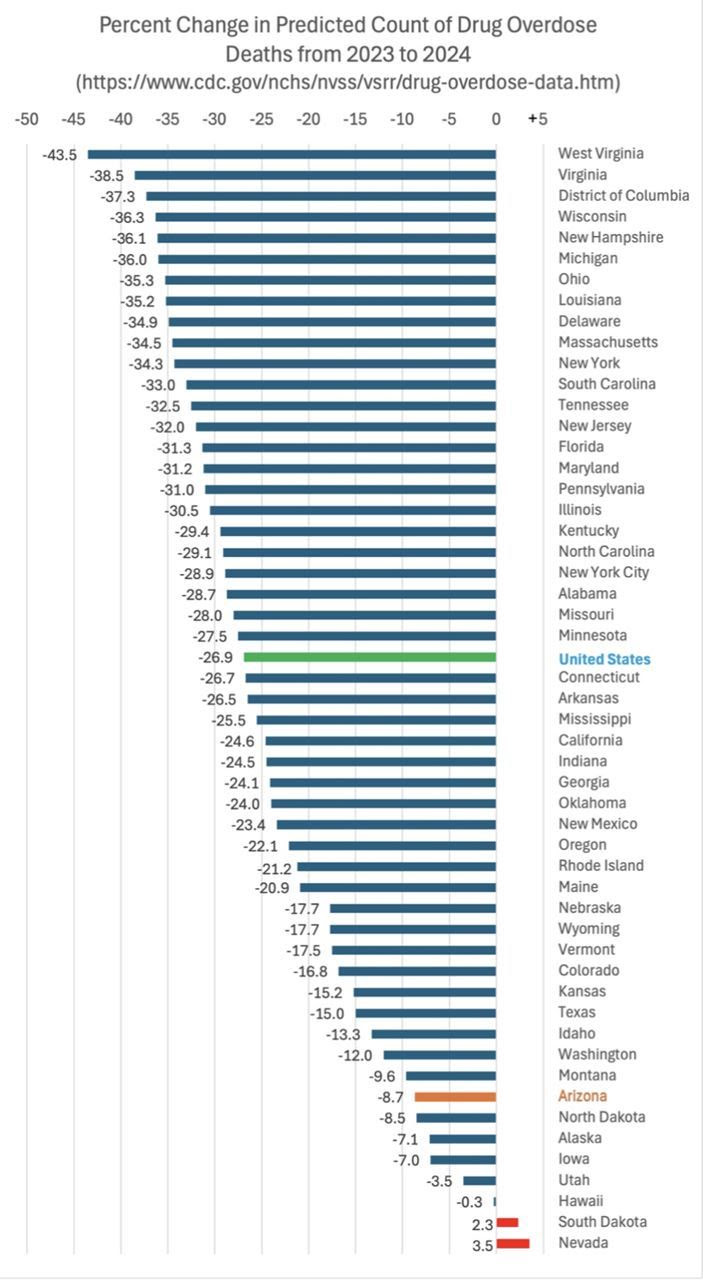|
Guest piece via AzPHA member Allan Williams, Ph.D. The March 16 AZPHA Policy Update (“A Turning Point in the Opioid Crisis”) reviewed a February 25 CDC report indicating a 24% decline in US drug overdose deaths over the 12-month period ending in September 2024 compared to the previous 12-month period. That finding has now been updated in a May 14 CDC report with data available through December 2024. The CDC’s Provisional Drug Overdose Death Counts reported that there were 29,646 fewer drug overdose deaths in the US in 2024, dropping from 110,037 in 2023 to 80,391 in 2024, an unprecedented 26.9% decline. This was the lowest number of overdose deaths since 2019. All but two states experienced declines, and the declines varied by over 100-fold (see chart below). The largest percent decline in overdose deaths was in West Virgina (43.5%) and the smallest decline was in Hawaii (0.3%). Small increases were found in Nevada (3.5%) and South Dakota (2.3%). Drug overdose deaths in Arizona declined from 2,780 in 2023 to 2,539 in 2024, an 8.7% decrease, one of the smaller decreases in the US. Regression analysis indicated a small (R2=0.22) but significant association between rates of drug overdose deaths in 2023 and the percent decline in deaths in 2024. The drug overdose deaths included in the CDC analysis included opioid deaths as well as other drugs such as cocaine and methamphetamine. Multiple drugs may be involved in drug deaths and these deaths are counted in each of the identified drug categories.
Ten-year Trends in Drug Overdose Deaths The CDC report included the reported and predicted numbers of drug overdose deaths in the US and in the states from 2015 to 2024. Using the “predicted” death counts for consistency with other findings and US census data for denominators, crude rates of drug overdose deaths per 100,000 from 2015 to 2024 were calculated and a Joinpoint trend analysis conducted for both the US and Arizona. Predicted US drug overdose death rates increased significantly by 10.8% per year from 2015 to 2022. From 2022 to 2024, the rate decreased by 15.1% per year, although the trend did not reach statistical significance. However, the rate in 2024 was significantly lower than the 2023 rate. The drug overdose death rate in Arizona also increased significantly by 14.0% per year from 2015 to 2021, then declined by a non-significant 4.6% per year. As with the US data, the rate in 2024 was significantly lower than the rate in 2023. No Single Explanation for the Decline This unprecedented decline in 2024 was widely reported by the media (CNN, Wash Post, NYTimes, PBS Horizon, among other sources) with numerous quoted experts and health officials agreeing that there is no single cause for the decline, but that multiple factors are likely to have contributed. As described previously in the March 16 Policy Update, these factors include increased access to and use of naloxone, better access to treatment, and possible changes in the drug supply. Increased availability and use of naloxone: Seven out of ten drug overdose deaths involve opioids. Naloxone is a drug that rapidly reverses an opioid overdose and is a critical tool in preventing opioid deaths. Since 12/31/21, virtually every state allowed licensed pharmacists to provide naloxone to patients without a prior prescriber visit through standing or protocol orders or other means. Retail pharmacy-dispensed naloxone prescriptions increased 122% from Q! 2019 to Q4 2023 (Rikard, 2024). This study did not include naloxone sold over the counter – approved by the FDA in March 2023 – or naloxone distributed outside of pharmacies by community and public health programs, first responders, hospitals, some libraries, vending machines, by mail, or other sources. According to the CDC, the overall rate of naloxone dispensed from retail pharmacies in the US increased from 0.3 to 0.6 per 100 persons from 2019 to 2023 and more than 2.1 million naloxone prescriptions were dispensed from retail pharmacies in 2023 (see chart below). Fentanyl Test Strips The rapid rise in opioid deaths – as well as the recent decline – was driven mainly by fentanyl. Fentanyl is often added to other illicit drugs by the suppliers, creating a greatly increased risk of an overdose. Fentanyl test strips (FTS) can identify the presence of fentanyl in drugs. Arizona legalized FTS in May of 2021. As of Dec. 2023, 45 states and the Dist. of Columbia had permitted the use of FTS and several studies have reported changes in drug behavior and safety awareness following positive FTS findings. Better Access to Treatment The Biden administration expanded access to addiction treatment medications such as methadone and buprenorphine which reduce opioid withdrawal symptoms (as well as expanding access to naloxone). In addition to federally funded drug treatment programs (which may or may not be continued by HHS), state and local governments in the US received more than $6 billion in opioid settlement funds in 2022 and 2023 (Arizona received over $97 million and is expected to receive over $1billion over 18 years). A review of reported spending of opioid funds by KFF, Johns Hopkins, and Shatterproof, indicated that states allocated an average of 18% of their funds for addiction and mental health treatment; 14% for housing, transportation, legal aid; 11% for harm reduction efforts such as naloxone; and 9% to programs to prevent substance abuse disorders. Overall, the top priority from early opioid spending was treatment, with $416 million targeted to residential rehab, outpatient counseling, medications of opioid use disorder, and more. The review did not include spending in 2024. Changes in Drug Use or Supply While the Biden administration took steps to limit the export from China of the precursor chemicals used to manufacture fentanyl, the impact remains uncertain. The US Customs and Border Protection reported a 19% decline in fentanyl seizures in fiscal 2024 compared to FY 2023. However, this followed an 83% increase in 2023. Cocaine seizures showed a 16% decline in 2024, following a 15% increase in 2023. Methamphetamine seizures, on the other hand, increased 24% increase in 2024, following a 20% decline in 2023. Given the up-and-down swings in annual and monthly drug seizures, these changes may reflect enforcement priorities and resources as much as changes in drug trafficking. Some experts theorize that the drug supply in some regions may include less fentanyl when combined with other drugs such as xylazine, while others suggest that fewer people are using drugs alone. Finally, with respect to a safer drug supply, it might be noted that a recent Canadian studyfound that two interventions—providing pharmaceutical-grade opioids to people who use toxic street drugs and decriminalization of drug possession—significantly increased opioid-related hospitalizations by 58% with no clear evidence of a change in opioid deaths. Reduced Number of Susceptible People It has also been suggested that there are fewer people at risk given the high death toll among regular users of fentanyl year after year. Grim, but maybe a factor. Will the Decline Continue? Despite the availability of opioid settlement funds, possible cuts to federally-funded programs to address drug abuse (including Medicaid) could undermine prevention efforts. In addition, a recent study found that 11% of adults surveyed in June 2024 reporting using illicit opioids during the past 12 months, a higher prevalence than has been previously reported. Use was higher among men, Black respondents, and younger age groups (drug overdose deaths are still the leading cause of death among 18-44 year olds, according to the CDC). Technical Notes:
|
|
|
|
|
|
|





